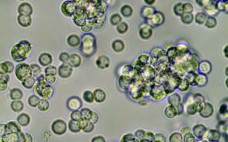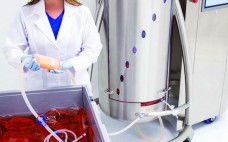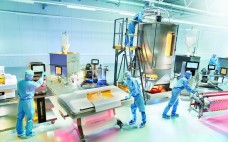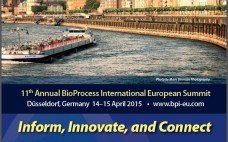Cell substrates managed in controlled culture environments have become, over the past few decades, the subject of intensive technological developments for the biomanufacturing of viral vaccines. The driving force of such work is an expanding demand for safety, high production capacities, cost savings, and flexibility. Egg, tissue, and primary-cell–based manufacturing methods of limited capacity are now considered to be outdated technologies. In the influenza vaccine field, for example, time delays in vaccine delivery (especially during pandemic responses) have increased concerns…
2015
The New Hybrid: Single-Use Systems Enabled By Process Automation
Much has been written in recent years about the union of single-use systems (SUS) and process automation. These two technology initiatives have been prevalent within biopharmaceutical manufacturing over the past decade and are two of the most predominant advancements in biomanufacturing. A basic survey of industry media and conference topics corroborates that premise (1). However, efforts to combine them remain in the early stages of technological fulfillment, with much work to be done in realizing their synergistic benefits. Here I…
Automation of a Single-Use Final Bulk Filtration Step: Enhancing Operational Flexibility and Facilitating Compliant, Right–First-Time Manufacturing
Single-use technologies have been implemented in biomanufacturing facilities all over the world. Inherently more flexible than stainless steel equipment, single-use technology allows for more rapid technology transfer by minimizing the time it takes to design, purchase, and qualify new capital assets. Rapid turnover between batches is facilitated with no need for protracted clean-in-place (CIP) and steam-in-place (SIP) regimes; the risk of product cross contaminations is reduced because single-use fluid-contact surfaces are never previously exposed to a biopharmaceutical product stream. For…
Measuring Pressure at Very Low Levels with High Accuracy in Single-Use Systems: Improved Performance and Single-Use System Testing
Measuring pressure in single-use systems (SUS) has become an integral part of both upstream and downstream bioprocess operations. Articles have been published on filtration applications (1), and integration into other SUS has been widely adopted. Additionally, information is available on low-pressure applications such as how to prevent overpressurization in single-use bioreactors (2). However, as users and applications both become more sophisticated, improved performance is sought for low-pressure applications (<1 psi) such as in single-use bioreactors. The reasons are two-fold: First,…
Implementing Flexible, Scalable, and Cost-Efficient Bioprocess Platforms: A Proven Project Management Approach
Although significant scientific progress has been made in the biotechnology industry, it has lagged behind other sectors — such as aviation and automotive — in developing, scaling up, and industrializing products coming out of R&D. The goal is to implement robust and reliable manufacturing processes for good manufacturing practice (GMP) market supply cost-effectively. But manufacturing methods for biologics have remained unchanged for decades, with large-scale, capital-intensive stainless steel facilities taking three to five years to build and remaining both energy…
From the Editor – March 2015
In this month’s lineup, you’ll find a common theme of balancing operating costs against company cultures and corporate philosophies. This is far from new: You can’t responsibly run a business without making such calculations! But the value in taking a fresh look at them lies in how we are forced to dust off and reassess some assumptions (even prejudices). It is easy (and all too human) to persist with outmoded assumptions — and we cannot afford to do that given…
Spotlight – March 2015
Niche-Disease: Fanconi Anemia by Cheryl Scott Fanconi anemia (FA) is a rare, genetic blood disorder that causes bone-marrow failure. It prevents bone marrow from producing sufficient new blood cells and/or makes it produce faulty blood cells. Although FA is a blood disorder, it can affect many organs, tissues, and systems. Children who inherit the condition are at higher risk of being born with birth defects. It is a complex and chronic disorder that can be psychologically demanding. FA is not…
Modern Technology Transfer Strategies for Biopharmaceutical Companies
Application of industrial biotechnology has changed dramatically over the past decade. Stainless steel process equipment has largely given way to disposable systems, facilitating easier and quicker process configurations and up-scaling. Suppliers generally made incremental advances in the quality of raw materials and consumables to ensure that those could more readily comply, “off the shelf,” with regulatory expectations. Once out-of-reach analytical equipment such as mass spectrometers and cell analyzers are becoming more common place in development laboratories, which better enables biopharmaceutical…
Expanded Change Protocols: Benefits, Cost Considerations, and Regulatory Views
The US FDA Office of Biotechnology Products’ quality by design (QbD) pilot program defines an expanded change protocol (eCP) as a particular type of comparability protocol that will “describe the quality by design, risk- based approach linking attributes and processes to product performance safety, and efficacy” (1). Sponsors have explored a wide range of potential applications for eCPs (e.g., movement within or beyond an established design space, site transfers, and additional process modifications supported by either a QbD or traditional…
Special Report – 11th Annual BioProcess International European Summit
Now in its 11th year, the BioProcess International European Summit will host more than 400 bioprocessing professionals from adademia and industry. Five major streams, seven keynotes, poster presentations, and an exhibition hall will take place 14–15 April at the SwissĂ´tel DĂĽsseldorf Neuss in Germany. Together, these opportunities fulfill the conference’s mission: to be the event where the biopharmaceutical industry connects to share new ideas and innovations across all phases of bioprocess development. In two days, the BPI European Summit will…








